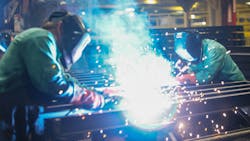Continued demand, limited production push trailer orders into 2022
Take the pandemic’s ongoing and variable impact—from local to global—on the supply chain, add it to the freight surge following the COVID-19 shutdown and commercial vehicle manufacturers’ typical early-cycle ramp-up challenges, and OEMs find themselves heading into spring with an unprecedented imbalance in the supply/demand equation. For trailer builders, until additional material, parts and labor can be locked-in, the math means either extending the backlog or turning away orders, or so suggest a couple of recent reports from ACT Research.
February net US trailer orders of 26,414 units fell nearly 16% from the previous month, but rose almost 88% compared to February of 2020. Before accounting for cancellations, new orders of 28.3k units were down 14% versus January, but 74% better than the previous February, according to this month’s issue of ACT Research’s State of the Industry: U.S. Trailer Report.
“Although it seems many OEMs are fully committed for dry vans and reefers this year, negotiations with fleets continue,” said Frank Maly, director–CV Transportation Analysis and Research at ACT Research. “While orders will continue to be booked, without meaningful increases in production rates, backlogs will remain extended.
“Although not official, the backlog-to-build ratio points to a de facto opening of 2022 orderboards by several OEMs, although one has publicly indicated that they are pausing further order acceptance in the short-term.”
Likewise, ACT Research reported that the freight-generating sectors of the economy are strong, freight rates are at record levels, and commercial vehicle demand is hot—but supply-chain constraints are restraining 2021 expectations. That’s from the release of the latest Commercial Vehicle Dealer Digest, which combines ACT’s proprietary data analysis from a wide variety of industry sources, paints a comprehensive picture of trends impacting transportation and commercial vehicle markets.
“With orders remaining hot through February reporting from ACT, backlogs and backlog-to-build ratios continuing to rise, and new vehicle inventories tight, the problem isn’t demand, but supply, as the new vehicle demand story remains unchanged,” ACT President and Senior Analyst Kenny Vieth said. “The supply chain’s ability to respond to demand will be the critical determinant of commercial vehicle production in 2021.
“To no small extent, it appears that the more traditional early-cycle ramping pains (tires, assorted cast parts, wiring harnesses) are taking a backseat to more cycle-specific constraints, which begin with the simultaneous global ramp in economic activity overlaid with pandemic-specific challenges.”
Vieth also noted that freight rates ended February at record levels (seasonally adjusted) and started March on an upswing.
“With the nation’s ports backed up for months, commodity prices soaring, the manufacturing sector heating, and the housing market already in full swing, there is unparalleled visibility to strong freight flows,” he said. “Freight is not typically a backlog business, but that is clearly not the case today.”
